New to Silent Hunter 4? Fresh out of the Atlantic theater? Have very little idea about the Pacific submarine theater? Then this post is for you! Alternately you can watch a 45 minute movie online:
History Channel special on US Sub attack plans
Prewar Doctrine -
How the US submarine came about
An escalation of tensions during the latter part of the 1930's indicating the possibility of a war in the Pacific led the US Navy to actively develop a submarine capable of supporting surface fleet operations.
Since Submarines were originally looked upon to serve as scouts and screens for the navy's capital warships; the desired "fleet boat" would be required to possess the speed, the range and the ability to maintain extended deployments which would be necessary for a war in the world's largest ocean.
This design evolved slowly during pre war years that culminated with the Tambor and gar class at the outbreak of war. Two more designs were evolved during the war. The design evolution, in chronological order is as follows:
S Class - WW1 submarine with 4 bow torpedos
Porpoise Class - 4 bow, and 2 aft torpedos
Salmon Class - 4 bow, and 4 aft tubes
Sargo Class - a refinement of the Salmon class, with the same number of tubes
Tambor/Gar Class - The first fleet boat that had the specifications the Submarine service was looking for with 6 bow and 4 stern torpedo tubes.
Gato Class - This was the "standard" fleet submarine of WWII. A refinement of the Tambor and Gar class, with the same number of torpedo tubes
Balao Class - The Balao class was an upgraded version of the Gato class, mostly noted for increased diving depth.
Outbreak of War - Entirely unprepaired
For the US Submarine Service, like the rest of the nation, Pearl harbor marked the entry to WW2, with one minor exception - they were present during the attack. The Japanese ignored the submarine base entirely. This would later prove to be a costly mistake.
 The USS Narwhal, and USS Tautog would later share credit for one of the first credited kills in WW2 by shooting down a Japanese Zero
The USS Narwhal, and USS Tautog would later share credit for one of the first credited kills in WW2 by shooting down a Japanese Zero
The U.S. Navy's submarine force was caught woefully unprepared for the type of warfare which they were about to face. All of the pre-war, peacetime training for the U.S. submarine commanders which was previously geared in support of the surface fleet, was now obsolete and impractical. Submarines were originally looked upon to serve as scouts and screens for the navy's capital warships. Unfortunately, following the devastating attack on Pearl Harbor virtually no surface fleet of any consequence remained in the Pacific waters for which to scout or screen. The United States Navy developers of tactical planning for submarine warfare never anticipated the situation that they found themselves in during those early days of the war. With the American Navy in the Pacific all but destroyed, the rules of submarine warfare had to be drastically changed. That change, came about via one simple and blunt order.
"
Execute unrestricted air and submarine warfare against Japan."
- Admiral R. Stark, Chief of Naval Operations in Washington, December 1941.
The Submarine war in the pacific had begun.
The Torpedos are fine, you're not using them correctly - so says the Naval Bureau of Ordinance
Much has been written about this, and is argubly the one piece of the history in the pacific that everyone has heard of. The problems were many.
- magnetic exploder which was kept so secret, the Naval bureau of ordinance was afraid to live fire test it during peace time, for fear that the secret would get out.
- Firing pin being bent, therefore torpedo not detonating when hitting the side of a ship at a 90 degree angle.
- Erratic depth control.
Some nice quotes about this fiasco:
"…the unhappy saga of the Mark 14 torpedo and its Mark VI magnetic exploder is, perhaps, a perfect example of the mayhem that can be created when experts bury their heads in the sand and steadfastly refuse to face facts."
"America entered the war with torpedoes far inferior to those of the enemy, and the fault lay squarely with the United States Bureau of Ordnance. It was ineffectual in research and development, inept in testing. It was inadequate in manufacturing, and feeble in its supervision of Newport. It was wanting in collegiality with the rest of the Navy, and it failed to trust those fighting under the Pacific surface."
"That…desk-bound staffers refused to listen to suggestions and criticisms from those they had sent into combat with this weapon seems, in retrospect, incomprehensibly stubborn and stupid…. The torpedo scandal of the U.S. submarine force in World War II was one of the worst in the history of any kind of warfare."
Needless to say, the Naval bureau of ordinance was on every submariner's s**t list. It wasn't until sometime in august, 1943 until the torpedos were tested, and the defects found. Until then, US submariners were going war, trusting their lives to a weapon that was unreliable, and could even turn against them by running erraticllly in a circular path. If you've ever heard the phrase, "Torpedo running hot straight and normal!", its because the hydrophone operator was listening for erratic movement in the torpedos!
Even during late war years, this erratic behavior was never fully rectified, as was exemplified when the USS Tang. She was about to head home after a very productive patrol, and was on the surface shooting her last torpedo at a damaged freighter when this torpedo, her last torpedo on board, ran circular and hit the Tang, sinking one of the most famous, and productive boats of the war.
A different kind of theater - a different kind of enemy
The pacific theater differed in many respects. Particuarlly were submarines were concerned. Unlike the atlantic, submarines in the pacific were tasked to do alot more then harvest as much tonnage of enemy ships as they can. They also actively participated in the overall effort to defeat japan. Some of these additional tasks included:
- Lifeguarding Rescues of downed pilots
- Wolf Packs operations
- Recon Missions
- Minelaying Missions
- Supply Missions
- Special Transport Missions
- Anti-Picket Boat Sweeps
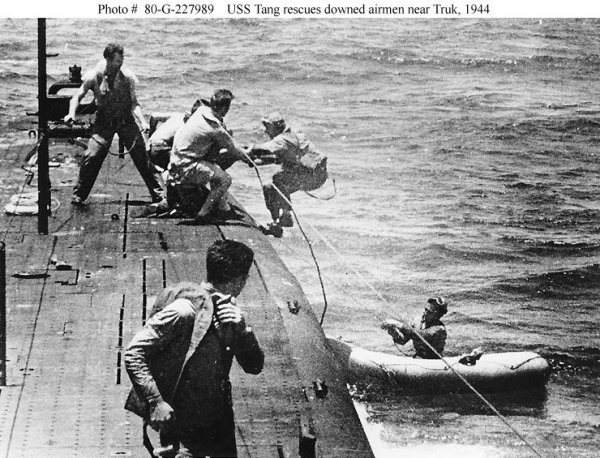 Rescuing of downed pilots
Rescuing of downed pilots
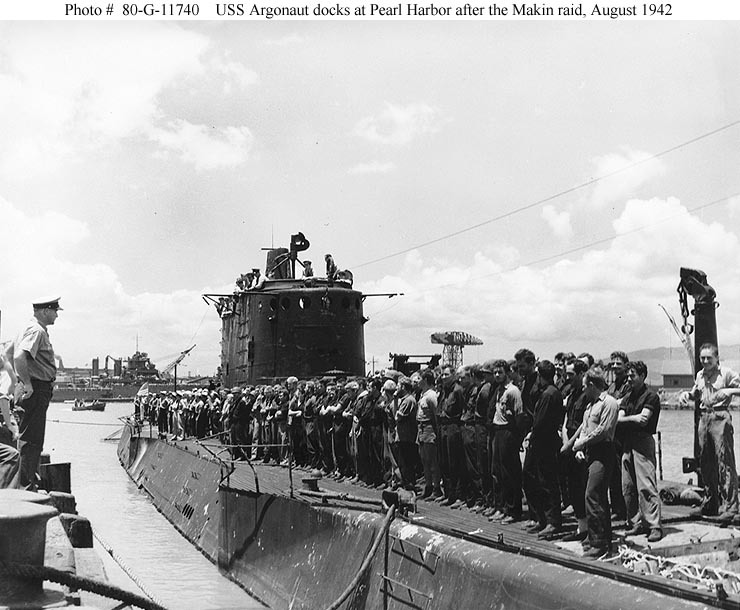 Docking at pearl harbor after what can be dubbed as a successful commando raid.
Docking at pearl harbor after what can be dubbed as a successful commando raid.
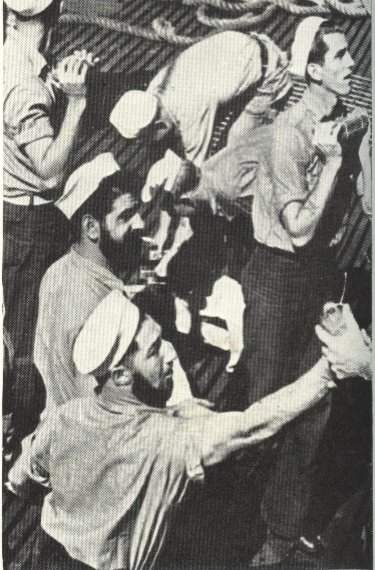 Unloading 20 tons of gold bars and silver pesos evacuated from the Philippines, at Pearl Harbor, 3 March 1942.
Unloading 20 tons of gold bars and silver pesos evacuated from the Philippines, at Pearl Harbor, 3 March 1942.

Naturally, when not doing some extra-curricular tasking, US submarines were doing what submarines do best, sink ships!
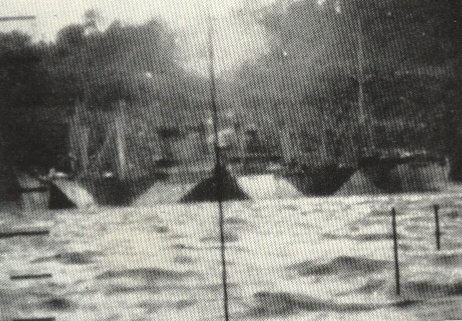 Encouraged to be aggressive, the raiding, (and sometimes shelling) of ancorages were not uncommon.
Encouraged to be aggressive, the raiding, (and sometimes shelling) of ancorages were not uncommon.
The enemy being fought, the Japanese Empire, was unlike any enemy fought against during WW2. Any rules of conflict that may have existed in the atlantic, were a bit less prevelant in the pacific. The japanese believed, and fought by, the code of bushido. It effect most every aspect of the war the Japanese participated in. The gist of this code, was that surrender was dishonorable. To surrender was to dishonor ones self, and ones family and ancestors. To surrender was to be subhuman. So more often then not the japanese, on a personal level, fought very tenaciously to the very end. Unfortunately several
attrocities were commited. From Pearl harbor, to batan, to Tarawa , to Iwo Jima, the pacific theater was a hotbed of war in its ugliest form.
Hatred for the enemy ran high, and woe be to the submariner or pilot who was captured by the japanese. Not all died, but not all lived, it was truly, ugly. It can be said, that compared to the atlantic, what the pacific lacked in massive scale, it more then made up for in intensity.
Structure of Submarine Operations
Submarines in the pacific operated out of three primary ports. Pearl Harbor, Fremantle, and Brisbane. Submarines were divided by numbered squadron called SubRons. Each squadron had a submarine tender which was responsible for the upkeep and maintance of the subs assigned to it.
The pacific theater was divided into two areas of operations, with each area headed by a admiral, similar in position to the germans Karl Donitz. These two operational heads were known as:
COMSUBPAC - short for commander submarines pacific
COMSUBSOWESPAC - short for Commander submarines South West Pacific
Naturally, each had their own idea on how the submarine war should be run.
Life on board -
It was hot.
Due to operational requirements, the habitiablity of life on a US submarine was indeed greater then most submarine forces of the time. However, how "easy" US submariners had it, is often misrespresented. Truth be told, life on a US Submarine was much like any other submarine.
Of life on board, one submarine veteran had this to say:
" It is said that submariners must learn to live with others even more so than in a marriage, and I agree. But the food was great. Elsewhere in the Navy the food wasn't bad, but on a submarine it was superb. There were always night rations if you were on duty, and the cooks whipped up marvelous meals."
"Since we were in the tropics, it also was extremely hot, sometimes as high as 130 degrees. We drank gallons of water and downed plenty of salt pills. The worst was when we submerged. That was rough because by four in the afternoon the heat, atmosphere and humidity inside were unbearable. Everybody suffered, but you managed to cope with it. Then, when we surfaced, even that warm tropical air felt good."
"We normally traveled a long way on our patrols, as much as 5,000 to 7,000 miles round trip, sometimes all the way from Perth, Australia, north across the equator. Actually, much of our missions was spent going to and returning from our patrol areas. The submarine usually carried food for 75 to 80 days. A typical patrol area was set up in rectangular form, such as an area 50 miles by 250 miles. The submarine patrolled back and forth near shipping lanes or harbors in the assigned area waiting for shipping. The goal was to wipe out Japan's merchant shipping and cut her supply lines."
"Heading out to our patrol area, the submarine stayed on the surface. But when we moved into range of our sector where Japanese planes might become a factor, the submarine remained underwater all day. At that time we'd flip-flop our schedules so that most activity occurred during the night, when the submarine could be on the surface and we could get fresh air. During the day, when we has less air available in the submersed submarine, we slept. Normally we dove about 4 a.m., just before sunrise, and remained underwater until about one half-hour after sunset. Breakfast was served around 4 p.m., and after surfacing at night we'd do all our work. About midnight we'd have dinner."
As for that air conditioning? Another sub vet called it a "glorified dehumidfier". The real purpose of the Air conditioning wasn't for the crews comfort, but to protect the eletrical systems inside the submarine from moister.
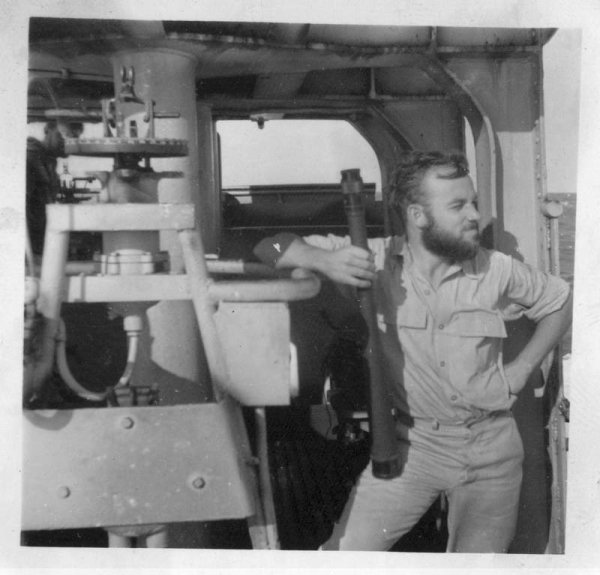 Enjoying that tropical breeze, shaving was optional, some submariners would have contests as to who could grow the fullest beard.
Enjoying that tropical breeze, shaving was optional, some submariners would have contests as to who could grow the fullest beard.
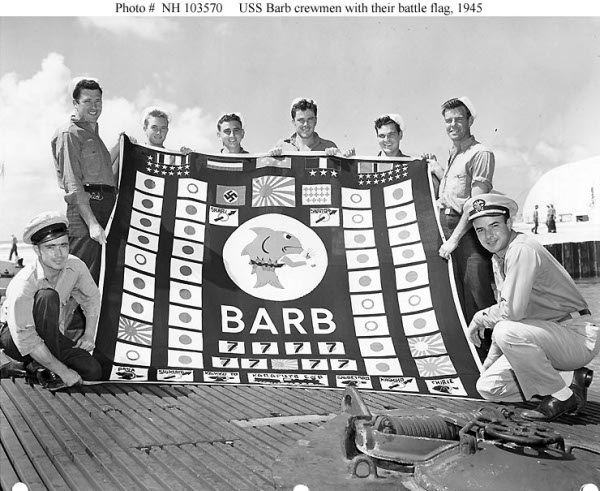
Generally speaking, US submarines didn't sport conning tower insignia. They didn't want individual boats to be indentifiable by the enemy. Instead they would have a battle flag that would reflect their boats accomplishments.

Although some conning tower artwork did appear from time to time.
It was not a pleasure cruise -
Of Occupational hazards, unsung heroism, and a Silent Service
The US Submarine service, earned the moniker, "The Silent Service" in many respects. Firstly, when under depth charge attack, one had to be quiet. Secondly, during wartime, all aspects of the submarine war were kept quiet, and not advertised. The US Navy didn't want to give the japanese any idea of success or failure in regards to submarine actions, or japanese ASW efforts. Last, but not least, most of the danger faced, the heroism, and the valor of these submariners go by unnoticed in the pages of history, the media, and the general public. The stories are many, all one has to do, is dig to find them.
A few highlights:
- The USS Gato, after surfacing from an intense depth charge attack discovered a live depth charge on her deck at the same time two enemy escorts were sighted headed in her direction. She outran them while disposing of the depth charge by setting it adrift on a rubber raft.
- The USS Gurnard one one depth charge attack, went deep to withstand an 88 depth charge barrage. The same boat later endurded 98 depth charges before the escort broke off its attack.
- The USS Billfish in one attack was inundated with depth charges by the Japanese. The constant barrage was threatening to tear the submarine apart and sink her. So she submerge 170 feet below test depth for 12 hours with a ruptured aft pressure hull and while the submarine was riddled with major leaks through the stern tubes and various hull fittings. She then took evasive actions by innovative maneuvers that retraced their path under the submarine's oil slick left by an explosion near the fuel ballast tanks. An officer was later cited as saying " There were three (Japanese) destroyers up there. We had a 412-foot test depth. I took the boat down to 650 feet. That was the only way to keep them from getting a depth charge underneath us."
- Another US submarine (whos name eludes me at the moment), endured a 48 hour depth charging before the escorts broke off its attack. The captain of this boat, with his sub low on batteries, and oxygen, was seriously considering surfacing and fighting with the deck gun. Thankfully the japanese destroyer broke off its attack before this plan of action was carried out.
One US sub vet when asked about some his experiences in the pacific, had this to day:
On attacking:
Quote:
|
"We'd try to get in under 1,500 feet, to get as short a shot as possible and give the target little time to evade the torpedo. The captain peered through the periscope on the approach in to get bearings. The crew and everything else on the submarine formed the weapon, and our captain was the man with his finger on the trigger. He made all the observations and decisions on when to fire. If a vessel was escorted, we'd fire and then get the hell out of there, listening for any sounds of explosions. You can hear a torpedo hit underwater ... it makes a clang and a bang ... but many sinkings were only confirmed after the war. Until that time it boiled down to the captain's word. If he was not sure of a sinking, he'd only report a hit. When you heard a torpedo explode, there was a lot of cheering throughout the submarine and guys saying, "Man, we sank a ship." We didn't realize that sailors, just like us, were dying. It's strange that you feel good about killing men, but you didn't think of that until later."
|
On most memoriable experience:
Quote:
|
"On Christmas Eve, 1942, the most memorable event in all the time I was in the war occured between New Guinea and New Britain. We were on the sirface at night ... almost midnight ... which would be Christmas day, when suddenly another submarine surfaces 1,000 yards astern. Everyone on the bridge clearly saw the sub because it surfaced in the moonlight. We quickly readied a torpedo, submerged, shot and sank the submarine. We never received credit for sinking it because no one saw it sink for sure, but we heard the hit, no question about that, and our sonar man heard the release of air associated with a sinking. I'll tell you, it was a cause for celebration that Christmas, but it was sobering for us because we realized it could have easily done the same to us."
|
On another experience:
Quote:
"In May 1943 we went off northern Japan, and was it cold! The water temperature was very low, making the inside of our submarine cold. We sank one merchant vessel in one attack before eluding the destroyer escorts, then fired a spread of torpedoes at another convoy and hit the lead freighter. (Those ships were later identified as the passenger/cargoman Iburi Maru and the freighter Shinju Maru, totaling 6,900 tons.) We dove deep and really got worked over by depth charges this time. After two hours the charges subsided, so we came back up to periscope depth, but the captain quickly spotted a Japanese plane circling above. The attacks resumed and lasted for another eight hours. Other than short periods to go to the head, we stayed on station all 10 hours. Three destroyers tried to edge us toward shore by heading us off, and while one destroyer ran at us and dropped depth charges, the other two observed for any signs of us. The attack seemed to go on and on forever, and guys were wondering, "God, aren't they ever going to quit?"
Every time we thought they'd left, another destroyer would come across our bow. A couple of men cracked under the pressure and began crying and shaking. Our captain, Dinty Moore, quietly had the men removed from the control room. They were all right afterward, but none of us said anything about it to them because we knew we all were on a microscopic edge of mentally breaking ... it could have been us. The captain finally got us out."
|